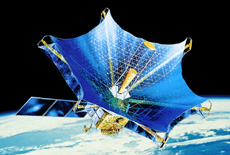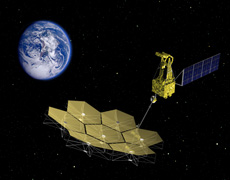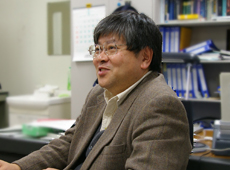

Q. You said that ASTRO-G will produce the highest-resolution images in history, but what new technologies are used?
Improving on HALCA, ASTRO-G's observation frequency range has changed from the wavelength band called the centimeter wave to the wavelength band called the millimeter wave. In almost all cases, HALCA made observations with a 60-mm wavelength; ASTRO-G will use a 7-mm wavelength. By reducing the wavelength by an order of magnitude, ASTRO-G will be able to obtain an angular resolution 10 times that of HALCA. However, in order to make observations with a 7-mm wavelength, we must enhance the mirror accuracy tenfold. On ASTRO-G, we plan to install a large deployable antenna with an aperture of approximately 9.3 meters, surface accuracy of 350µm (the thickness of two sheets of paper) and a weight of 200 kg. Since it is not possible to carry the nearly 9-meter antenna aboard the rocket, we will fold it like an umbrella and deploy it in space. This method was developed specifically for ASTRO-G using Engineering Test Satellite VIII, also known as KIKU No. 8 (ETS-VIII), which was launched in 2006.
In terms of other technology, ASTRO-G will broaden the transmission band up to 1 Gigabit per second, enabling a large amount of data transmission. We will also reduce the thermal noise by cooling the receiver. By introducing accurate orbit determination to the centimeter level, and by improving the attitude control, it enable us to perform the phase reference observation, and we will make it ten times more sensitive than HALCA.
No matter how much data we acquire, unless we know the precise position of the satellite's antenna, we cannot use the data for research. We will use GPS (Global Positioning System) and a laser reflector to obtain the three-dimensional position of the satellite in space. We will irradiate the laser light to the satellite in order to reflect it, and measure the position of the satellite by tracking the light's round-trip time to Earth. In addition, in order to measure the position of the radio source, we measure it based on a reference star; the more frequently we can switch the observation of the reference star and the target stellar object, the higher the accuracy of the phase reference observation is performed. ASTRO-G will be able to determine a reference star within 3 degrees of the target star and observe the two stars every 15 seconds, so that we can accurately measure the position of the target star. ASTRO-G will be the world-leader in astrometric observation.

Radio-Astronomy Satellite HALCA

Radio-Astronomical Satellite ASTRO-G
Q. What are your plans for the future development of ASTRO-G?
Our goal is to launch ASTRO-G in 2012. JAXA is developing it in cooperation with the National Astronomical Observatory of Japan and several universities. We are still working on upgrading the performance of the instruments, but the basic design of the satellite is almost complete. By the spring, we will have finalized the shape and weight of the satellite.
Q. What international cooperation are you planning?
Since the Space VLBI project performs astronomical observation in conjunction with many radio telescopes on the ground, cooperation with radio observatories and space agencies around the world is indispensable. We are asking international radio observatories to point their radio telescopes in the same direction at a specified time, so that we can all observe a particular astronomical object at the same time, collect the data in one place, and correlate the sets of data in order to obtain the image of the object. Currently, many countries perform radio astronomy observations, including the United States, Canada, Australia, Korea, China, and European countries including the United Kingdom and Germany. With ASTRO-G, these observation groups will be unified. Also, there is a proposal to construct a satellite-receiving network for the exclusive use of ASTRO-G.
We are holding international meetings to discuss how to acquire observation data. There has not been a final decision, but some observations will be designed by the group that developed the ASTRO-G, while others will be based on proposals from researchers around the world. Ground-based radio telescopes already offer such observations on a competitive basis. Even at the Nobeyama Radio Observatory of the National Astronomical Observatory of Japan, where I previously worked, much of the observation time was offered to outside scientists. Although the extent to which ASTRO-G will make observation data public has not yet been determined, I think the data will be made available on the Web site and in other formats.

Nobeyama Radio Observatory (Courtesy of National Astronomical Observatory of Japan)

Q. What are you hoping to observe with ASTRO-G?
I hope to see a true image of the region around a black hole. I have seen the exterior of an active galaxy using radio telescopes on the ground, but the resolution is too low to see the center of the galaxy. Seeing an image of innermost region of an active galactic nuclei for the first time will be something new. My philosophy of studying science is “seeing is knowing the truth.” For example, a friend of mine tells a story of hiking when he heard the sound of falling water. He thought he had found a waterfall, but it turned out to be a dam. We cannot know the truth until we actually see it. So I do want to see an active galaxy core, and the behavior of a jet emerging around a black hole. I want to see these phenomena with my own eyes.

Q. What attracts you to astronomy?
I am interested in extreme states in nature, such as very old, distant, cold and vast worlds. Miraculous phenomena occur around a black hole that are beyond our earth-bound imagination. When we actually see them, we may be able to discover things that have never been proposed by any theory. There are many unknown phenomena in the universe. One of the attractions of astronomy is that we might make an unexpected “wow!” discovery. Because ASTRO-G's performance will be far superior to that of previous satellites, I expect that it will bring one revelation after another. To fulfill these great expectations, I sincerely want to make ASTRO-G a successful operation.
Doctor of Science, Professor, Department of Basic Space Science, Institute of Space and Astronautical Science, JAXA.
Dr. Tsuboi graduated in 1988 from the Department of Astronomy of the Graduate School of Science at the University of Tokyo. He has been a Research Associate at the National Astronomical Observatory of Japan, Associate Professor at the Ibaraki University, Professor at the National Astronomical Observatory of Japan and the University of Tokyo, and Director at the Nobeyama Radio Observatory of the National Astronomical Observatory of Japan. He has held his current post since 2007. His major research field is radio astronomy.
X-ray Astronomy Satellite
Suzaku
Infrared Imaging Satellite
AKARI
Solar Physics Satellite
HINODE
Radio-Astoronomical Satellite
ASTRO-G